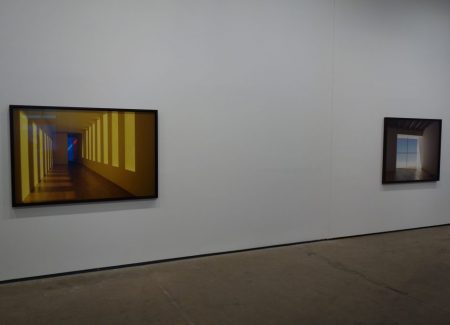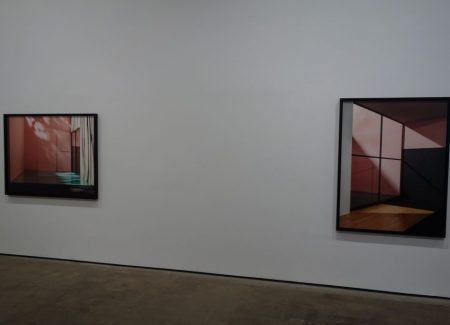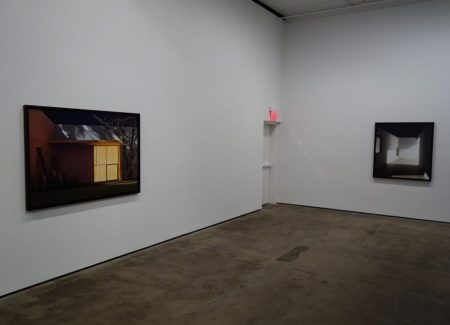JTF (just the facts): A total of 12 color photographs hung against light gray walls: 10 in the main gallery, 1 in the smaller North gallery, and 1 over the director’s desk. All are framed archival pigment prints mounted to dibond, dated either 2016 and 2017, and issued in editions of 5+2AP. Sizes are roughly 47×69 inches or the reverse. (Installation shots below.)
Comments/Context: Some artists fear being identified with a single idea or subject for long. Believing that personal growth means relentless mutation, and wary of the acclaim earned from their previous work, they shed their skins every year or so. Kiki Smith, Annette Lemieux, Robert Cumming, James Welling, and Richard Prince have tried to be moving targets throughout their exhibition history. Mike Kelley’s retrospective was like a group show.
Other artists discover a meaningful concept and chart a career that follows its implications. They never veer too far off course. Roy Lichtenstein’s witty mind saw possibilities in the Ben-Day dot and cartoon reproduction for 35 years. The monk-like Conceptual artist On Kawara painted the calendar date in white letters on a monochrome canvas nearly every day from 1966-2013, each of the almost 3,000 pictures virtually the same and yet unique.
Numerous photographers who gained reputations as Post-modernists found signature styles in the 1980s that have sustained them ever since: David Levinthal’s and Laurie Simmons’ dolls and toysets; Barbara Kruger’s charged rhetoric in block letters, emblazoned on appropriated images and fenced by red borders; Cindy Sherman’s costume drama self-portraits; Louise Lawler’s photos of pictures in museums and luxury homes; Barbara Kasten’s mirrored still-lifes; Jeff Wall’s light boxes and learned art history references.
Their artistic practices, viewed initially as subversive of photographic tradition, have long ago been validated as entirely respectable by academia, museums, and the market.
James Casebere is another Pictures Generation artist who has began as a disrupter and became an honored Middle-Aged Master. For almost 40 years he has photographed architectural spaces—walls, rooms, nooks, dormers, hallways, prison cells, churches, streets, neighborhoods—that he built on tabletops out of foam-core, painted and lighted himself. People in these scenes are absent, represented only by their tools (shovels, ladders, chairs, tables, pottery) and not as miniaturized figures. Whether in black-and-white or color, the chilly, subdued elegance of a Casebere photograph is instantly recognizable.
His 2010 show at Sean Kelly featured aerial views (birds or drones or God?) of hillside towns in Dutchess County, NY that were uncharacteristically expansive and marked by a sense of community. The irrational extremes of scale between crowds of dwellings and the curving perspectives recalled the rolling Midwest landscapes of Grant Wood. A flaring “early morning” light in more than one photograph conveyed an airy optimism unusual in Casebere’s previous work.
His new series has brought him back to earth but continues the warming trend. Recreating domestic spaces by the Mexican Modernist architect Luis Barragán, who had the walls of his nakedly geometric designs painted in vibrant unmodulated colors, Casebere seems to be invoking what Barragán called “emotional architecture.” The views are tightly cropped and indrawn, with the concrete or wooden floors and the timbered ceilings often framing a central window or doorway through which light bathes a restful scene.
In several respects this body of work adheres to formulas Casebere established long ago. Although based on actual Barragán structures built near Mexico City in the 1950s, ’60s, and ‘70s—Casa Gálvez, Casa Prieto Lopez, Casa Giraldi, Casa Cristóbal—the photographs bear generic titles: Courtyard with Orange Wall, Empty Studio, Library, Vestibule, Flooded Courtyard with Tree. These are not documents of the sort we might come upon in Architectural Digest or a Sotheby’s real estate site, the nomenclature reminds us, but abstracted reconstructions. In some instances, he has altered the original configuration of a house, removing staircases. The only signs of a human presence in these spaces are a few pulque fermenting pots on an outdoor patio, miniaturized and cloaked in the dark shadows of “night.”
There is a persistent tension in Casebere’s work between the sentimental light that he favors and the intellectual content of the subjects he is drawn to. A reconciliation appears more possible in this series, as the lemony yellows and rosy pinks of these tropical buildings seem to have struck a chord with him. Upon receiving the Pritzker Prize in 1980, Barragán declared that “in alarming proportions the following words have disappeared from architectural publications: beauty, inspiration, magic, sorcery, enchantment, and also serenity, mystery, silence, privacy, astonishment. All of these have found a loving home in my soul.”
Before accepting that Casebere is endorsing this Romantic creed without irony, though, one should notice that certain photographs (e.g. Reception Room, Yellow Passage) are based on famous reproductions of Barragán’s buildings rather than on Casebere’s personal interpretation of them. Whether he actually visited these places remains unclear, perhaps deliberately so. Strong emotion for him, of any sort, seems tempered by the Postmodern tenet that experience is always mediated.
The one incongruous photograph in this generally upbeat show about the legacy of Modernism is a scale model of an Albert Speer-designed podium. Framed against a gray sky, the empty concrete structure is ringed with colorful flags of nondescript nations. Thanks to photography, it’s not hard to imagine who Casebere might have in mind as the invisible speaker about to address the crowds through the three tiny microphones.
Will he continue to be satisfied with photographing ghostly, unpopulated miniatured architectural spaces in the studio? Or by following an austere set of self-imposed rules for so many years has he cornered himself? The images in this show compared to the last are disappointing—not emotional enough—but I wouldn’t bet against him.
Collector’s POV: The prints in this show are generally priced at $50000 each, with one image at $45000. Casebere’s work has become consistently available in the secondary markets, with a handful of lots available every year. Recent prices at auction have ranged between $2000 and $75000.











